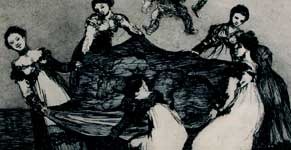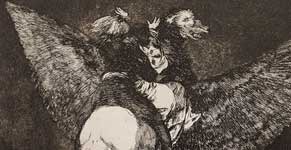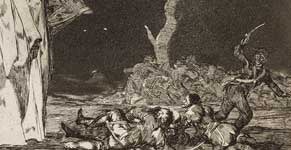Disparates
The last major series of prints made by Goya was Disparates ( “Follies” ), which was also called Proverbios (‘Proverbs’) in the first edition. He began work on it in 1816, but had to leave it unfinished when he departed for France in 1824 before the return of absolutism following the Liberal Triennium. This is why it was not published during the artist’s lifetime. Eighteen of the 22 prints that make up the series were published in 1864 the Royal Academy of Fine Arts of San Fernando and the last four were published in Paris in 1877.
The enigmatic images of the Disparates prints are difficult to interpret and the series lacks a narrative unity or logic. We do not know how Goya would have ordered the prints. Only the titles of 13 are known, thanks to test etchings, and all start with the word disparate (‘folly’). Those that seem playful, light-hearted and carnivalesque take on a spooky and sinister air due to the dramatic qualities of the nocturnal light. Most of the subjects in Disparates had already been addressed by Goya in Caprichos, but now he did so in a dramatic and grotesque way.
The Disparates series must be interpreted as irrational. Fear of the unknown; the ridiculing of forced marriages; manifestations of eroticism and loving relationships as all-consuming; the fantasy of flying; and mockery of those surrounding King Ferdinand VII and who boasted of being ‘loyal’, either due to self-interest or hypocrisy, seem to explain some of these Disparates. Goya is pessimistic in these works and seems to have lost confidence in man.





